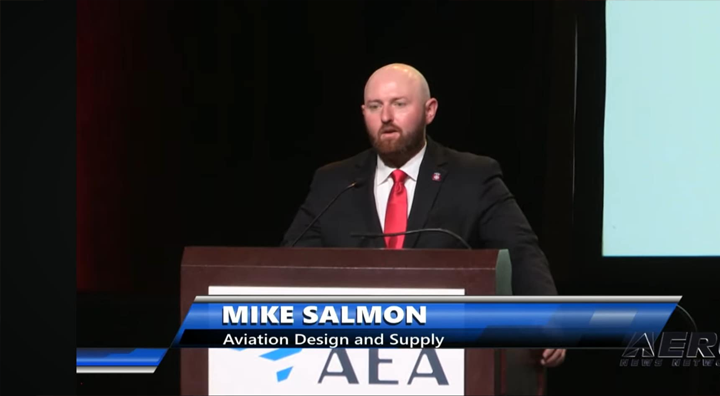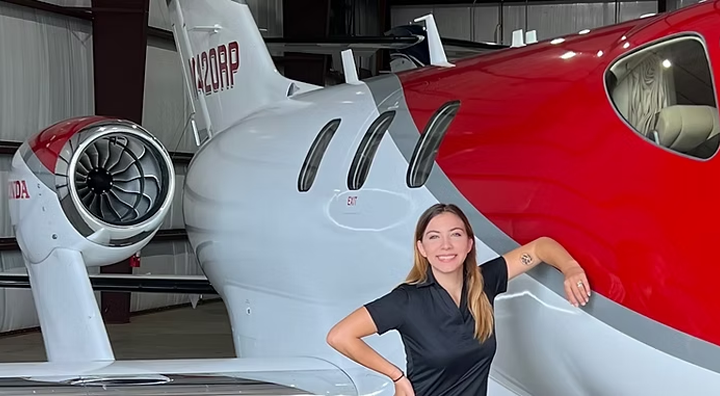The Real Flying Car is Here: Sam Bousfield’s Journey to Make Science Fiction Reality
By Shawn Staerker
Remember watching The Jetsons or Back to the Future and thinking “When will we finally get flying cars?” Well, stop wondering – they’re actually here, and they’re absolutely incredible. Meet Sam Bousfield, the visionary behind the Samson Sky Switchblade, who’s turning childhood dreams into driveable, flyable reality.
From Architect to Aviation Revolutionary
Sam’s story doesn’t start in a garage tinkering with engines. It starts with a different kind of blueprint – architectural ones. As an architect, Sam had a unique perspective that would change everything.
“An architect is part engineer and part artist,” Sam explains. “Artists dream the future, right? They’re the guys that kind of lay it out in front of the engineers and say, ‘Hey, here, boys, this is where we’re going.'”
Looking at transportation, Sam saw something most people missed. While we’re stuck in traffic jams, the future clearly points skyward – just like in Star Trek and Star Wars. But how do you get from here to there? Sam’s “aha” moment was realizing we needed something that bridges both worlds: a vehicle that drives AND flies.
The Switchblade: Not Your Average Flying Car
Here’s where Sam’s story gets really exciting. Instead of asking “How do you make a flying car?” like everyone else, he flipped the question: “What’s the best layout for a vehicle that both drives and flies?”
The answer? Three wheels – lightweight, sleek, and perfect for both aircraft and ground vehicles. But the Switchblade isn’t just any three-wheeler. This thing is a transformer that would make Optimus Prime jealous.
Picture this: You’re driving what looks like a super-sleek sports car. Then, at the airport, you push a button. In just three minutes, wings unfold from the belly, a tail swings out, and you’re ready to take off. It’s like something straight out of a superhero movie, except it’s real.
When Reality Hits (And You Redesign Everything)
Sam’s journey wasn’t all smooth flying. In November 2023, the Switchblade took its first flight – a massive milestone that revealed a major problem. The ducted fan system didn’t deliver the high performance Sam promised.
“We could go into production with what we have, but it’s not going to be high performance in the air,” Sam recalls. The team faced a tough choice: settle for “good enough” or go back to the drawing board.
They chose the harder path. Despite being a year behind schedule and burning through resources, they completely redesigned the propulsion system. Why? Because Sam and his team promised something special, and they were determined to deliver.
Innovation That Actually Makes Sense
The redesigned Switchblade features a hybrid electric system that’s absolutely brilliant. Instead of relying on one type of engine that might go out of production (which actually happened to Sam once before!), the hybrid system can adapt to almost any power source.
“We’re kind of engine agnostic,” Sam explains. Plus, it sets them up for the all-electric future when battery technology catches up. Right now, batteries would be dead weight in the air, so the gas generator powers electric motors directly – no heavy batteries needed.
The wings? They fold in a way that would make airline engineers jealous, growing larger for takeoff (like airliner wings) but tucking completely inside the vehicle for ground travel. Everything – wings, tail, propeller – disappears inside, protecting your flying surfaces from parking lot dings.
Safety First (Because Flying Cars Can’t Afford Not To Be)
Sam didn’t mess around with safety. Every system has dual locks, dual load paths, and clear indicators so you can see everything’s secure before takeoff. There’s even an optional whole-vehicle parachute system, though Sam notes many pilots prefer the extra fuel weight instead.
“You do have to watch it – you can’t be full bore on your throttle and pull the parachute,” Sam explains. That’s why Switchblade owners get five hours of specialized training, including when and how to use emergency systems.
The Numbers That’ll Blow Your Mind
Ready for this? The Switchblade has over 2,400 reservations from 50+ countries, and Sam barely advertises. When they tested Facebook ads in India, they had to shut them down in 10 days because orders were flooding in faster than they could handle.
At 200-300 thousand dollars, the Switchblade costs about the same as a high-end sports car – except you’re getting a sports car AND an airplane that flies 160 mph. Compare that to buying both separately, and it’s an incredible value.
The sweet spot? Those 250-500 mile trips that are too short for airlines but too long for comfortable driving. With 5,000 airports across the US (versus only 300 with commercial service), you can land much closer to your actual destination.
Building the Future, One Button Push at a Time
Here’s something cool: the Switchblade is sold as an experimental aircraft kit, but Sam’s team has revolutionized the building process. Instead of requiring master craftsman skills, they’ve developed automated carbon fiber manufacturing where builders literally just push a button and let machines do the precision work.
“You don’t really need a ton of skill in that,” Sam says. “You still learn and you’re still producing the parts and you’re meeting the 51% [owner assembly requirement].”
Training the Next Generation of Pilot-Drivers
For non-pilots (which is 80% of Sam’s customers), the Switchblade program includes innovative VR-based flight training. Students practice maneuvers over and over in virtual reality until they’ve mastered them, then demonstrate their skills in actual aircraft. It’s faster, cheaper, and more effective than traditional training.
The Vision That Keeps Growing
The current Switchblade is just the beginning. Sam’s team is already planning certified versions that could compete with cargo aircraft like the Cessna Caravan. Imagine express mail delivery that can drive directly to your door after landing at a nearby airport.
“We’re looking at the future of transportation,” Sam explains. “We’re trying to help people move about the world more easily, faster, more freedom.”
Advice for Future Innovators
Sam’s message to young dreamers? Don’t listen to the naysayers. “Don’t listen to anybody who tells you it’s not worth doing or it’s worthless because that’s not the kind of person you want in your environment if you’re a creative person.”
His practical advice: Start with something you can actually finish. The Switchblade took 14 years to develop – maybe pick something easier for your first project! Do surveys, find supportive people, and prove your idea works on a smaller scale before tackling your flying car.
The Future is Now
The Switchblade proves that the gap between science fiction and reality isn’t as big as we thought. Sam and his team are literally building the future of transportation, one three-wheeled transformer at a time.
Want to hear more about Sam’s incredible journey and the technical details behind the Switchblade? Check out his full interview on The Future in Flight Podcast. You’ll get the complete story of how one architect’s vision is reshaping how we think about getting from point A to point B – whether that’s on the ground or 10,000 feet in the air.
The age of flying cars isn’t coming someday. It’s here now, and it’s more amazing than we ever imagined.
Want to hear more about Sam and the future of Samson Switchblade flying car? Check out his full interview on The Future in Flight Podcast Episode 18!


